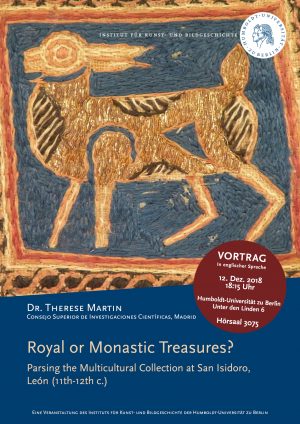Datum/Zeit
Date(s) - 12/12/2018
18:15 - 20:00
Veranstaltungsort
HU Hauptgebäude, Hörsaal 3075 [1]
auf Google-Maps ansehen [2]
Kategorien
- Vortrag [3]
Vortrag (in Englischer Sprache): [4]
[4]
Dr. Therese Martin, Consejo Superior de Investigaciones Científicas, Madrid
Royal or Monastic Treasures? Parsing the Multicultural Collection at San Isidoro, León (11th-12th c.)
A medieval treasury acts as a material witness to the interests and aspirations of those who established it. Beyond pious donations to favored churches, treasuries could function as a source of gifts for allies, which bound them with obligations, or as prestigious possessions for the owner’s ostentation before an elite audience. Pieces made of precious metals served to store wealth in the form of silver and gold until the need for liquidity arose. An example of this is recorded in an 1112 donation by Queen Urraca of León-Castilla (r. 1109-1126), who gave the town of Conturiz in 1112 to the Cathedral of Lugo in exchange for “one hundred silver marks in sacred altar ornaments” to be used for her soldiers’ salaries. Chronicles and documents chart the changing circumstances of textiles worked with gold, making clear not only their great importance for royal and ecclesiastic self-presentation, but also for the economy of the powerful.
Although there is ample bibliography on treasuries from French, Germanic, Italian, and English lands, Iberian collections prior to the late Middle Ages have not yet received the same level of scholarly attention. And this despite the fact that a royal-monastic institution like San Isidoro de León still holds a substantial collection of silver caskets, carved ivories, and exquisite silks from the tenth through twelfth centuries. For San Isidoro, the material reality of surviving luxury objects from as far away as Scandinavia or Fatimid Egypt is analyzed together with an archive of documents, chronicles, and miracles to identify the Leonese treasury’s royal founders and ecclesiastical holders.